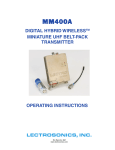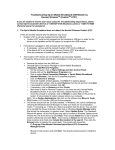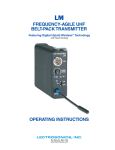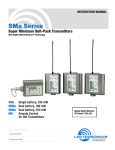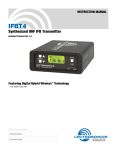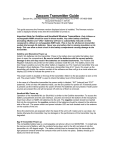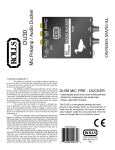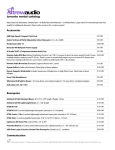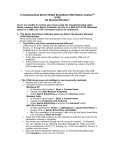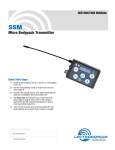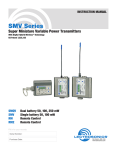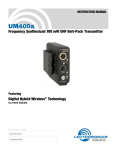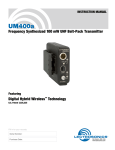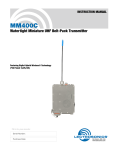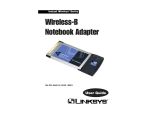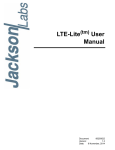Download Lectrosonics UH400A user manual June 2004
Transcript
UH400A FREQUENCY AGILE PLUG-ON UHF TRANSMITTER Featuring Digital Hybrid Wireless™ Technology U.S. Patent Pending OPERATING INSTRUCTIONS LECTROSONICS, INC. Rio Rancho, NM www.lectrosonics.com UH400 2 LECTROSONICS, INC. Frequency Agile Plug-on UHF Transmitter Thank you for selecting the Lectrosonics UH400A frequency agile, plug-on transmitter. The UH400 combines over 80 years of engineering experience with the very latest components, in a design that addresses the most demanding professional applications. The design of the UH400A was the direct result of numerous conversations with users, staging and touring companies and dealers across the US. The specific concerns and needs brought up in these conversations led directly to the development of the operational features offered on the UH400A. Two hundred fifty six frequencies are user selectable in 100 kHz steps to alleviate interference problems in travelling venues. The UH400A is a rugged, machined aluminum package. Selectable voltage phantom power is provided allowing the UH400 to be used with the widest variety of microphones. LEDs located on the UH400A front panel make quick and accurate level settings without having to view the receiver. The battery compartment accepts any 9 volt alkaline or lithium battery and makes a positive connection via self-adjusting contacts. Only the UH400A transmitter is covered in this manual. Companion receivers are covered in separate manuals. The UH400A will operate with any 100, 200 or 400 Series Lectrosonics receiver in the same frequency group. TABLE OF CONTENTS GENERAL TECHNICAL DESCRIPTION ...................................................................................... 4 INTRODUCTION .................................................................................................................... 4 DIGITAL HYBRID TECHNOLOGY ......................................................................................... 4 INPUT LIMITER ...................................................................................................................... 4 NO PRE-EMPHASIS/DE-EMPHASIS .................................................................................... 5 PILOT TONE SQUELCH ....................................................................................................... 5 WIDE-BAND DEVIATION ....................................................................................................... 5 LONG BATTERY LIFE ........................................................................................................... 5 FREQUENCY AGILITY .......................................................................................................... 5 POWER SWITCH ................................................................................................................... 6 POWER ON/OFF LED ............................................................................................................ 6 CONTROLS AND FUNCTIONS .................................................................................................... 6 PHANTOM POWER VOLTAGE SELECT SWITCH .............................................................. 6 FREQUENCY SELECT SWITCHES ...................................................................................... 7 INPUT JACK ........................................................................................................................... 7 MODULATION LEDS ............................................................................................................. 7 COMPATIBILITY MODE INDICATORS ................................................................................. 8 MIC LEVEL ............................................................................................................................. 8 FREQUENCY BLOCKS AND RANGES ....................................................................................... 9 OPERATING INSTRUCTIONS ................................................................................................... 10 ATTACHING THE MICROPHONE ....................................................................................... 10 MIC LEVEL OPERATING TIP .............................................................................................. 10 SELECTING THE COMPATIBILITY MODE ......................................................................... 10 ADJUSTING THE TRANSMITTER FREQUENCY ............................................................... 11 BATTERY REPLACEMENT ................................................................................................. 11 TROUBLESHOOTING ................................................................................................................ 12 SPECIFICATIONS AND FEATURES ......................................................................................... 13 SERVICE AND REPAIR ............................................................................................................. 14 RETURNING UNITS FOR REPAIR ............................................................................................ 14 LIMITED ONE YEAR WARRANTY ............................................................................... Back Cover The UH400 transmitter is FCC type accepted under Part 74: 470 - 608MHz and 614 - 806MHz Rio Rancho, NM – USA 3 UH400 GENERAL TECHNICAL DESCRIPTION +5V / +15V / +48V BIAS SUPPLY INPUT JACK Hi/Lo Pass Filter <-- (See Input Jack under Controls and Functions for details.) Input Amp Audio Audio Level Shunt Limiter A-D Converter D-A Converter 11001001 11001001 Encoded Audio + Pilot Tone Switching Power Supply Digital Signal Processor 9V +3.3v +3.2v +1.8v +6v -3v Bicolor Power LED Microprocessor Bicolor Modulation LEDs Freq Switches Phase Locked Loop Voltage Controlled Oscillator 11.3 MHz Reference 50 Isolator Transmitter UH400 Block Diagram INTRODUCTION The 400 system uses ±75 kHz wide deviation for an extremely high signal to noise ratio. The switching power supplies provide constant voltages to the transmitter circuits from the beginning (9.3 volts) to the end (5.5 volts) of battery life. The input amplifier uses an ultra low noise op amp for quiet operation. It is gain controlled with a wide range dual envelope input compressor which cleanly limits input signal peaks over 30 dB above full modulation. DIGITAL HYBRID TECHNOLOGY All wireless links suffer from channel noise to some degree, and all wireless microphone systems seek to minimize the impact of that noise on the desired signal. Conventional analog systems use compandors for enhanced dynamic range, at the cost of subtle artifacts (known as “pumping” and “breathing”). Wholly digital systems defeat the noise by sending the audio information in digital form, at the cost of some combination of power, bandwidth and resistance to interference. The Lectrosonics Digital Hybrid WirelessTM system (hereafter called Digital Hybrid) overcomes channel noise in a dramatically new way, digitally encoding the audio in the transmitter and decoding it in the receiver, yet still sending the encoded information via an analog FM wireless link. This proprietary algorithm is not a digital implementation of an analog compandor but a technique which can be accomplished only in the digital domain, even though the inputs and outputs are analog signals. (As of this writing, 4 the patent is still pending, so we cannot reveal detailed information about the algorithm at this time.) Channel noise still has an impact on received signal quality and will eventually overwhelm the receiver. The Digital Hybrid simply encodes the signal to use a noisy channel as efficiently and robustly as possible, yielding audio performance that rivals that of wholly digital systems, without the power and bandwidth problems inherent in digital transmission. As always, these advantages come at a cost. The Digital Hybrid system requires fairly intensive digital processing in both the transmitter and the receiver. These processors cost money, take up space and consume power. The Digital Hybrid system also requires that the underlying RF link be of excellent quality, with better frequency response and distortion characteristics than that required by conventional systems. Because it uses an analog FM link, the Digital Hybrid enjoys all the benefits of conventional FM wireless systems, such as excellent range, efficient use of RF spectrum, and long battery life. However, unlike conventional FM systems, the Digital Hybrid has done away with the analog compandor and its artifacts. INPUT LIMITER The 400 series transmitters employ a digitally-controlled analog audio limiter just before the analog-to-digital converter. The limiter has a range of more than 30 dB for excellent overload protection. A dual release envelope makes the limiter acoustically transparent while maintain- LECTROSONICS, INC. Frequency Agile Plug-on UHF Transmitter ing low distortion. It can be thought of as two limiters in series, connected as a fast attack and release limiter followed by a slow attack and release limiter. The limiter recovers quickly from brief transients, so that its action is hidden from the listener, but recovers slowly from sustained high levels, to both keep audio distortion low and preserve short term dynamic changes. The Modulation LEDs indicate limiter activity. When the 20 LED glows red and the -10 LED glows green with occasional red flickers, this indicates that the limiter is active and that the transmitter is fully modulated (audio level is between +0 and +10 dB). When the -10 LED glows solid red, this indicates that the level is +10 dB or more into limiting. Occasional forays by the -10 LED into the red are desirable for most applications, since the distortion introduced by the limiter is so minimal and full modulation is thus assured. We strongly recommend setting the audio level of the transmitter high enough so that the -10 LED occasionally flickers red. Generally speaking, some limiting is desirable in normal operation to improve the signal to noise ratio of the system. The limiting action is not audible and does not create distortion. A highly trained ear would hear only the compression of the peaks in the audio signal, which is desirable with most recorders and many sound reinforcement systems. NO PRE-EMPHASIS/DE-EMPHASIS The signal to noise ratio of the 400 system is high enough to preclude the need for conventional pre-emphasis (HF boost) in the transmitter and de-emphasis (HF roll off) in the receiver. Pre-emphasis and de-emphasis in an FM radio system usually provides about a 10 dB improvement in the signal to noise ratio of the system, but the high frequency boost in the transmitter must be removed in a purely complementary manner or else the frequency response of the original audio signal will be altered. PILOT TONE SQUELCH The 400 system utilizes one of 256 different ultrasonic tones between 25 and 32 kHz, that modulate the carrier to operate the receiver squelch. The pilot tone frequency is chosen according to which of the 256 channels has been selected by the frequency switch setting. The basic benefit of the pilot tone squelch system is that the receiver will remain muted until it receives the pilot tone from the matching transmitter, even if a strong RF signal is present on the carrier frequency of the system. The UH400 extends this concept even further by insuring that all transmitters in a system have different pilot tone frequencies so that even spurious RF from the wrong transmitters can’t open the receiver squelch. WIDE-BAND DEVIATION A ±75 kHz deviation improves the capture ratio, signal to noise ratio and AM rejection of a wireless system dramatically, compared to the more commonly used ±15 kHz deviation. LONG BATTERY LIFE Switching power supplies throughout the design allow over 4.5 hours of operation using a single 9 volt alkaline battery. (A 9 volt lithium battery will provide over 12 hours of operation.) The battery contacts are spring loaded to prevent “rattle” as the unit is handled. FREQUENCY AGILITY The transmitter section uses a synthesized, frequency selectable main oscillator. The frequency is extremely stable over a wide temperature range and over time. Two rotary switches, located on the side panel of the unit, provide 256 frequencies in 100 kHz steps over a 25.5 MHz range. This alleviates carrier interference problems in mobile or traveling applications. Pre-emphasis can also cause distortion in the receiver. As this signal is passed through the IF filters in the receiver, distortion can be produced, most noticeably at full modulation. De-emphasis cannot be applied until the signal is converted into audio, so there is no way around this problem short of eliminating pre-emphasis altogether. Neither of these problems occur in the 400 system Rio Rancho, NM – USA 5 UH400 CONTROLS AND FUNCTIONS MODULATION LEDs –10 –20 INPUT JACK POWER ON/OFF LED FREQUENCY 1.6MHz 100kHz POWER SWITCH NO PHTM INPUT JACK MIC LEVEL Top View PHTM LEVEL 5V 48 PWR OFF POWER SWITCH The three position OFF/PHTM/NO PHTM Power Switch turns the unit on or off, and selects either phantom power, or no phantom power. Regardless of which position the switch is set, the pilot tone muting system effectively prevents “thumps” or transients from occurring during power up or power down. The PHTM (center) position of the power switch turns on the phantom power value selected by the Phantom Power Voltage Select switch, while the NO PHTM (fully on) position disables phantom power. Note In order to minimize accidents, be careful to use the center (PHTM) position only when necessary and keep the Phantom Power Voltage Select switch in the 5 V position. (See Phantom Power Voltage Select switch.) POWER ON/OFF LED This LED glows green when the battery is good. When the lamp glows red, there are about 30 minutes of operation left with the recommended lithium battery, and about 20 minutes of battery life left with an alkaline battery. The lamp will flash red when there are only a few minutes of life remaining in either type of battery. Note A NiMH battery will give little or no warning when it is depleted. If you wish to use NiMH batteries in this unit, we recommend installing a fully charged batteries, noting the length of time that the batteries will run the unit and in the future use somewhat less than that time to determine when the battery needs to be replaced. F 0 1 2 E 3 4 5 A 9 8 7 6 F 0 1 2 3 4 5 D C B A 9 8 7 6 FREQUENCY SWITCHES (BEHIND DOOR) V PHANTOM POWER VOLTAGE SELECT (RECESSED) 15V Side View Control Panel This transmitter may be used with a wide variety of microphones. The 3-pin XLR connector allows the transmitter to be used with any dynamic microphone, as well as many two wire positive bias lavaliere systems (such as those systems supplied by Lectrosonics). 6 E D C B A weak battery will sometimes light the POWER LED to the “good” green indication immediately after being put in the unit, but will soon discharge to the point where the LED will go red or shut down (just like a flashlight with “dead” batteries). If the Power LED fails to light when power is applied, replace the battery. PHANTOM POWER VOLTAGE SELECT SWITCH This switch selects from three phantom voltages when the PWR switch is in the mid position. The voltages are: • 5 volts for lavaliere microphones, • 15 volts for some professional mics requiring high current and for many common stage mics that will operate over a wide phantom voltage range of 12 to 48 volts. With the proper adapter, this position can also be used with T power microphones. See our web site for details on finding or making the proper adapter. • 42 volts for microphones that do in fact require a supply greater than 15 volts. (See below for a discussion of why 42 and not a “true” 48 volts.) For longest battery life use the minimum phantom voltage necessary for the microphone. Many stage microphones regulate the 48 volts down to 10 volts internally anyway, so you might as well use the 58 volt setting and save some battery power. If you are not using a microphone for the input device, or are using a microphone that does not require phantom power, set the Power Switch to the No PHTM position (No Phantom Power). This is the fully up position of the Power Switch. Phantom power should only be used with a fully floating, balanced device such as most microphones with a 3-pin XLR connector. If you use the phantom power with an unbalanced device or if pins 2 or 3 are DC connected to ground, then you will draw maximum current from the power supply. The UH400A is fully protected against such shorts but the 9 volt battery will be drained at twice its normal rate. LECTROSONICS, INC. Frequency Agile Plug-on UHF Transmitter The transmitter can supply 4 mA at 42 volts, 8 mA at 15 volts, and 8 mA at 5 volts. The 42 volts setting actually supplies the same voltage to a 48 volt microphone as the DIN standard arrangement due to a dynamic biasing scheme that does not have as much voltage drop as the DIN standard. The 48 volt DIN standard arrangement protects against shorts and high fault current with high resistance in the power supply feeds to pins 2 and 3. This protects the supply if the supply current is accidentally shorted to ground and also keeps the microphone from being attenuated by the power supply. The UH400A improves on those functions and is able to use less power from the battery by using constant current sources and current limiters. With this dynamic arrangement the UH400A can also supply more than twice the current of competing 48 volt plug on units and provide four times the current to some very high end 18 volt microphones. The 5 volt setting is provided for lavaliere microphones made by us and others. Do not power lavalieres from the 15 or 48 volt setting as the microphone will be most likely destroyed. Lectrosonics makes an adapter, MCA5X, that will adapt our standard TA5F 5 pin microphones to the UH400A. This adapter also provides protection against excessive phantom voltage. If voltages higher than 5 volts are applied to the adapter, a Zener diode will shunt excess voltage to ground. The microphone won't work until the voltage is correctly reduced to 5 volts. If you have an older lavaliere mic that was wired directly to an XLR for use with the earlier UH200's, we strongly recommend building our protection circuit into the XLR to prevent accidental destruction of the lavaliere. FREQUENCY SELECT SWITCHES Two 16 position rotary switches adjust the center frequency of the carrier within the transmitter’s frequency block. The 1.6 MHz is a coarse adjustment and the 100 kHz is the fine adjustment. Each transmitter is factory aligned at the center of its operating range. The default position of the frequency select switches is in the center of the transmitter’s range. INPUT JACK Standard 3-pin Switchcraft XLR type. Pin 2 is signal, pin 3 is a floating signal ground, and pin 1 is case ground (see schematic below). The UH400A is self-locking onto a standard microphone. To Mic Preamp +5V / +18V / +42V I 1uh 1000 1uh 4.7uf 1 2 3 1uh Input Jack Schematic Note If severe noise is experienced when the microphone is moved with respect to the UH400A, the cause is an unbalanced condition between pins 2 and 3 of the microphone. MODULATION LEDS The Modulation LEDs indicate the proper setting of the MIC LEVEL control. There are two bicolor modulation LEDs that can light either red or green depending on the amount of gain applied. The transmitter should be set so that both LEDs glow green, with the -20 LED occassionally blinking red. MODULATION LEDs –10 –20 Top View Signal Level Left Switch 1.6 MHz Right Switch 100 kHz Frequency Select Switches Less than -20 dB -20 dB to -10 dB -10 dB to +0 dB +0 dB to +10 dB Greater than +10 dB Rio Rancho, NM – USA -20 LED -10 LED Off Green Green Red Red Off Off Green Green Red 7 UH400 COMPATIBILITY MODE INDICATORS MIC LEVEL The Modulation LEDS will blink when power is first applied to the transmitter to indicate the selected operating mode. Immediately after, all LEDS will blink together red, then green, followed by the Modulation LEDs (-20 and -10) blinking to indicate the operating mode. Used to adjust the audio input level for the proper modulation. The –20 and –10 LEDs will blink: • Once for 100 Series mode • Two times for 200 Series mode • Three times for mode 3 (Contact Factory for Details • Four times for 400 Series mode N O P HTM 5V P HTM MIC LEVEL MODULATION LEDs –10 –20 V Control Panel POWER ON/OFF LED Top View 8 LEVEL 48 PW R O FF 1 5V LECTROSONICS, INC. Frequency Agile Plug-on UHF Transmitter FREQUENCY BLOCKS AND RANGES Each UH400 transmitter is built to cover a pre-selected range of frequencies (a “block”). The transmitter will tune to any of 256 different frequencies within this factory assigned block. (See Operating Frequencies (MHz).) The block number is determined by this formula: 25.6 × Freq. (MHz) = Lowest freq. (MHz) in the block Use the two Frequency Switches to set the transmitter’s carrier frequency to match the associated receiver. For example, assume that the transmitter and receiver are both assigned Block 25 and the receiver’s switches are set to 658.400 MHz. Subtract the lowest frequency for Block 25 from the assigned frequency to determine the switch settings for the transmitter. To determine a block number from a frequency: 658.400 -640.000 18.400 Freq. (MHz) divided by 25.6 = Block number It is handy to remember these formulas, in case you do not have a copy of the table. For example, suppose you need to know which block covers 685.500 MHz, without using the table: 685.500 divided by 25.6 = 26.77734375 The first two digits left of the decimal are the block number. In this case, 685.500 MHz falls within block 26. Divide the result by 1.6 and round down the nearest two digits to determine the coarse Frequency Switch setting. 18.4/1.6 = 11.5 or 11 (B on the switch dial) Multiply the coarse Frequency Switch setting by 1.6 and subtract that number from the original result to determine the setting for the fine Frequency Switch. 11 x 1.6 = 17.6 Part of block 23 is not used since it covers a 608 to 614 MHz band that is illegal for use with wireless microphones. Operating Frequencies (MHz): Block 21 537.600 - 563.100 Block 22 563.200 - 588.700 Block 23 588.8 00- 607.900; 614.100 - 614.300 Block 24 614.400 - 639.900 Block 25 640.000 - 665.500 Block 26 665.600 - 691.100 Block 27 691.200 - 716.700 Block 28 716.800 - 742.300 Block 29 742.400 - 767.900 Block 30 768.000 - 793.500 (export only) 18.400 - 17.600 .800 or 8 Therefore, the Frequency Switch settings for this transmitter would be B8. Rio Rancho, NM – USA 9 UH400 OPERATING INSTRUCTIONS TO ATTACH Hold the transmitter case and rotate the collar in the direction shown. Do this over a soft surface as the microphone may pop off suddenly Press firmly, listen for click. Depress collar fully. Click! TO REMOVE Pull on mic to insure locking. ATTACHING THE MICROPHONE 1. Insert the UH400A into the XLR connector on the bottom of the selected microphone. Listen for the “click” that indicates the transmitter assembly has locked on to the microphone. Gently pull on the mic to insure proper locking has occurred. 2. If necessary, set the phantom power voltage for the mic. If the mic does not require phantom voltage, set the Phantom Power Voltage Select switch to 5V to reduce the possibility of damage to the mic when the transmitter is powered up. 3. Set the MIC LEVEL control to minimum (fully counterclockwise). same level that will be used during the program. Increase the Mic LEVEL control until the -20 LED glows red and the -10 dB glows green with occasionally red flickers. This indicates full modulation. 6. Once the gain has been adjusted, the remainder of the audio sound system can be energized and adjusted. MIC LEVEL OPERATING TIP The Mic LEVEL control should not be used to control the volume of your sound system or recorder levels. The Mic LEVEL control matches the transmitter gain with the user’s voice level and mic’s position. If the audio level is too high — both red LEDs will glow solid red. This condition may reduce the dynamic range of the audio signal. POWER SWITCH N O P HTM 5V P HTM LEVEL 48 V PW R O FF 1 8V PHANTOM POWER VOLTAGE SELECT Control Panel 4. Turn on the transmitter by setting the Power Switch to PHTM, if the mic requires phantom power, or to NO PHTM, if the mic does not require phantom power. (Refer to the specifications for the mic you are using to determine if phantom power is required.) 5. Hold the mic as you will when you will be using it, or if the mic will be stationary, such as attached to a lectern or mic stand and speak or sing into it at the same voice level that will be actually used during the program. 5. Start with the Mic LEVEL control at maximum counterclockwise, then observe the front panel Modulation LEDs. Slowly turning the Audio LEVEL control clockwise while talking into the mic at the 10 If the audio level is too low — neither LED will glow, or only the –20 LED will glow green. This condition may cause hiss and noise in the audio. Different voices will usually require different settings of the Mic LEVEL control, so check this adjustment as each new person uses the system. If several different people will be using the transmitter and there is not time to make the adjustment for each individual, adjust it for the loudest voice. SELECTING THE COMPATIBILITY MODE This unit is capable of working with Lectrosonics 400 series digital hybrid receivers or 200 and 100 Series analog receivers. It is also capable of working with analog wireless receivers from other manufacturers (contact the factory for details). The transmitter can be easily set to the compatibility mode of the matching receiver using only the supplied screwdriver and a battery. NOTE: The UH400A is supplied from the factory as a 400 series transmitter 1. Ensure the battery is good. If the Power LED lights up when the Power Switch is set to PHTM or NO PHTM, the battery is good and correctly installed. 2. Turn off the transmitter. LECTROSONICS, INC. Frequency Agile Plug-on UHF Transmitter 3. With a small screwdriver (included with your unit), set the frequency change switches to CC. (for Change, Change). To gain access to these switches, slide the access door open with a fingernail. operating frequency in 100 kHz steps to find a clear channel. If it is not possible to find a clear channel using the 100 kHz switch, return it to its original position and change the 1.6 MHz switch by one click then try the 100 kHz switch again. BATTERY REPLACEMENT E D C B A F 0 1 2 3 4 5 9 8 7 6 Left Switch 1.6 MHz E D C B A F 0 1 The UH400A transmitter is powered by a standard alkaline 9 volt battery. It is important that you use ONLY ALKALINE OR LITHIUM batteries for longest life. Standard zinc-carbon batteries marked “heavy duty” or “long-lasting” are not adequate. They will provide only about five minutes of operation. Similarly, ni-cad rechargeable batteries only give one hour of operation, and will also run down quite abruptly. Alkaline batteries provide about 4.5 hours of operation while lithium batteries will run the unit for about 12 hours. 2 3 4 5 9 8 7 6 RELEASE DOOR SWING OPEN OBSERVE POLARITY Right Switch 100 kHz Frequency Select switches 4. Set the Power Switch to NO PHTM briefly – just a couple of seconds for the front panel LED’s to light up, then immediately turn the unit off. 5. Change the Frequency Select switches to one of the following settings: MODE SWITCH SETTINGS 100 Series 200 Series Mode 3* 400 Series Digital Hybrid 1,1 2,2 3,3 (Contact factory for details.) 4,4 6. Turn the transmitter on, when the front panel LEDs light up, immediately turn the unit off. 7. Change the switches to 0,0. 8. Energize the transmitter and verify the new compatibility mode. The front panel –20 and –10 LEDs will blink: • Once for 100 Series mode • Two times for 200 Series mode • Three times for mode 3 (Contact Factory for Details • Four times for 400 Series mode The Compatibility Mode will remain set until changed with the above procedure. ADJUSTING THE TRANSMITTER FREQUENCY Battery Compartment Action To open the battery compartment, press upward on the cover door in the direction of the arrow as shown in the drawing. Only slight, sliding pressure is needed to open and close the battery door. Swing the door open and take note of the location of the positive (+) and negative (-) terminals. Insert the new battery correctly and close the cover by reversing the opening procedure. Note that the battery door will NOT close if the battery is inserted incorrectly, since the terminals will hit a protective polarity barrier. Don’t force the battery door closed. If it is difficult to close, the battery is in backwards. The battery life will be affected by the amount of phantom power supplied to any microphones that require it. A high drain 48 volt microphone can shorten battery life by 40% or more. A light drain 18 volt microphone will make little or no difference in battery life. The only way to be sure is to test the transmitter and microphone combination with a brand new battery. Then will you be sure of the combination's battery life. CAUTION If you are experiencing interference from another signal on your frequency, you may want to change the operating frequency of your system. This is done with the Frequency Switches. The left switch changes the operating frequency by 1.6 MHz per step and the right switch changes it 100 kHz per step. If you are experiencing interference, change the Lithium batteries will expand and swell if allowed to go into a deep discharge. Be sure to remove lithium batteries as soon as the battery is depleted. If lithium batteries are allowed to fully discharge while still inside the battery compartment, they will be very difficult to remove. Stuck lithium batteries can be avoided by removing the label wrapping around the battery before use. This will allow the battery to swell but will still leave enough room in the compartment for the battery to fall out normally. Rio Rancho, NM – USA 11 UH400 TROUBLESHOOTING Before going through the following chart, be sure that you have a good battery in the transmitter. It is important that you follow these steps in the sequence listed. SYMPTOM POSSIBLE CAUSE TRANSMITTER BATTERY LED OFF 1. Battery is inserted backwards. 2. Battery is dead. NO TRANSMITTER MODULATION LEDs 1. 2. 3. 4. 5. RECEIVER RF LAMP OFF 1. 2. 3. 4. NO SOUND (OR LOW SOUND LEVEL), RECEIVER MOD LEVEL LEDs ARE ON NO SOUND (OR LOW SOUND LEVEL), RECEIVER MOD LEDs ARE OFF Gain control turned all the way down. Battery is in backwards. Check power LED. Mic capsule is damaged or malfunctioning. Mic cable damaged or mis-wired. Phantom power not enabled for mic that requires it. Transmitter not turned on. Transmitter battery is dead. Receiver antenna missing or improperly positioned. Transmitter and receiver not on same frequency. Check switches/display on transmitter and receiver. 5. Operating range is too great. 1. Receiver output level set too low. 2. Receiver output is disconnected; cable is defective or mis-wired. 3. Sound system input is turned down. 1. Transmitter gain (audio level) set too low. 2. Faulty microphone 3. Phantom power not enabled for mic that requires it. DISTORTED SOUND 1. Transmitter gain (audio level) is far too high. Check mod level lamps on transmitter and receiver as it is being used. (Refer to the Operating Instructions section for details on gain adjustment) 2. Receiver output may be mismatched with the sound system or recorder input. Adjust output level on receiver to the correct level for the recorder, mixer or sound system. 3. Excessive wind noise or breath “pops.” Reposition microphone and/or use a larger windscreen. 4. Transmitter is not set to same frequency as receiver. Check that frequency select switches on receiver and transmitter match. HISS AND NOISE – AUDIBLE DROPOUTS 1. Transmitter gain (audio level) far too low. 2. Receiver antenna missing or obstructed. 3. Operating range too great. EXCESSIVE FEEDBACK 1. Transmitter gain (audio level) too high causing the limiter to reduce the dynamic range which in turn causes feedback. Check gain adjustment and/or reduce receiver output level. (Refer to the Operating Instructions section for details on gain adjustment) 2. Transmitter too close to speaker system. 3. Mic is too far from user’s mouth. 12 LECTROSONICS, INC. Frequency Agile Plug-on UHF Transmitter SPECIFICATIONS AND FEATURES Operating frequencies: 537.600 to 607.900 MHz; 614.100 to 793.500 MHz Frequency selection: 256 frequencies in 100 kHz steps RF Power output: 100 mW (nominal) Pilot tone: 25 to 32 kHz; 5 kHz deviation (in 400 Series mode) Frequency stability: ± 0.002% Deviation: ± 75 kHz max. (in 400 Series mode) Spurious radiation: 60 dB below carrier Equivalent input noise: –118 dBV, A-weighted Input level: Nominal 2 mV to 300 mV, before limiting; Greater than 1.0 V maximum, with limiting. Input impedance: 1 k Ohm Input limiter: Soft limiter, >30 dB range Gain control range: 43 dB; semi-log rotary control Modulation indicators: Dual bicolor LEDs indicate modulation of –20, -10, 0, +10 dB referenced to full modulation. Low frequency roll-off: –12 dB/octave; 70 Hz Controls: Control panel knob adjusts audio gain. Rotary switches on bottom panel adjust transmitter frequency. Audio Frequency Response: 90 Hz to 20 kHz, +/-1dB Note The audio is deliberately rolled off at 70Hz using a 12 dB/octave filter. This filter cannot be disabled. Signal to Noise Ratio (dB): SmartNR No Limiting W/ Limiting OFF 103.5 NORMAL 107.0 108.5 111.5 FULL 108.5 113.0 Note The dual envelope “soft” limiter provides exceptionally good handling of transients using variable attack and release time constants. The gradual onset of limiting in the design begins below full modulation, which reduces the measured figure for SNR without limiting by 4.5 dB Total Harmonic Distortion: 0.2% typical (400 Series mode) Antenna: Built in Battery Type: 9V alkaline or lithium Battery Life: 4.5 Hours with alkaline 9 Volt, 12 hrs with lithium (Battery life will vary with battery brand, phantom power voltage setting and mic current drain.) Weight: 6.5 ozs. with lithium battery, no mic Overall Dimensions: 1.5 x 1.5 x 4.2 inches (Not including microphone.) Emission Designator: 190KF3E Specifications subject to change without notice. The FCC requires that the following statement be included in this manual: This device complies with FCC radiation exposure limits as set forth for an uncontrolled environment. This device should be installed and operated so that its antenna(s) are not co-located or operating in conjunction with any other antenna or transmitter. Rio Rancho, NM – USA 13 UH400 SERVICE AND REPAIR If your system malfunctions, you should attempt to correct or isolate the trouble before concluding that the equipment needs repair. Make sure you have followed the setup procedure and operating instructions. Check out the interconnecting cords and then go through the TROUBLESHOOTING section in the manual We strongly recommend that you do not try to repair the equipment yourself and do not have the local repair shop attempt anything other than the simplest repair. If the repair is more complicated than a broken wire or loose connection, send the unit to the factory for repair and service. Don’t attempt to adjust any controls inside the units. Once set at the factory, the various controls and trimmers do not drift with age or vibration and never require readjustment. There are no adjustments inside that will make a malfunctioning unit start working. The LECTROSONICS Service Department is equipped and staffed to quickly repair your equipment. In-warranty repairs are made at no charge in accordance with the terms of the warranty. Out-of-warranty repairs are charged at a modest flat rate plus parts and shipping. Since it takes almost as much time and effort to determine what is wrong as it does to make the repair, there is a charge for an exact quotation. We will be happy to quote approximate charges by phone for out-ofwarranty repairs. RETURNING UNITS FOR REPAIR You will save yourself time and trouble if you will follow the steps below: A. DO NOT return equipment to the factory for repair without first contacting us by letter or by phone. We need to know the nature of the problem, the model number and the serial number of the equipment. We also need a phone number where you can be reached 8 a.m. to 4 p.m. (U.S.- Mountain Standard Time). B. After receiving your request, we will issue you a return authorization number (R.A.). This number will help speed your repair through our receiving and repair departments. The return authorization number must be clearly shown on the outside of the shipping container. C. Pack the equipment carefully and ship to us, shipping costs prepaid. If necessary, we can provide you with the proper packing materials. UPS is usually the best way to ship the units. Heavy units should be “double-boxed” for safe transport. D. We also strongly recommend that you insure the equipment, since we cannot be responsible for loss of or damage to equipment that you ship. Of course, we insure the equipment when we ship it back to you. Mailing address: Lectrosonics, Inc. PO Box 15900 Rio Rancho, NM 87174 USA Shipping address: Lectrosonics, Inc. 581 Laser Rd. Rio Rancho, NM 87124 USA World Wide Web: http://www.lectrosonics.com 14 Telephones: Regular: (505) 892-4501 Toll Free (800) 821-1121 FAX: (505) 892-6243 Email: [email protected] LECTROSONICS, INC. Frequency Agile Plug-on UHF Transmitter Rio Rancho, NM – USA 15 LIMITED YEAR WARRANTY LIMITED ONE ONE YEAR WARRANTY The equipment is warranted for one year from date of purchase against defects in materials or workmanship provided it was purchased from an authorized dealer. This warranty does not cover equipment which has been abused or damaged by careless handling or shipping. This warranty does not apply to used or demonstrator equipment. Should any defect develop, Lectrosonics, Inc. will, at our option, repair or replace any defective parts without charge for either parts or labor. If Lectrosonics, Inc. cannot correct the defect in your equipment, it will be replaced at no charge with a similar new item. Lectrosonics, Inc. will pay for the cost of returning your equipment to you. This warranty applies only to items returned to Lectrosonics, Inc. or an authorized dealer, shipping costs prepaid, within one year from the date of purchase. This Limited Warranty is governed by the laws of the State of New Mexico. It states the entire liablility of Lectrosonics Inc. and the entire remedy of the purchaser for any breach of warranty as outlined above. NEITHER LECTROSONICS, INC. NOR ANYONE INVOLVED IN THE PRODUCTION OR DELIVERY OF THE EQUIPMENT SHALL BE LIABLE FOR ANY INDIRECT, SPECIAL, PUNITIVE, CONSEQUENTIAL, OR INCIDENTAL DAMAGES ARISING OUT OF THE USE OR INABILITY TO USE THIS EQUIPMENT EVEN IF LECTROSONICS, INC. HAS BEEN ADVISED OF THE POSSIBILITY OF SUCH DAMAGES. IN NO EVENT SHALL THE LIABILITY OF LECTROSONICS, INC. EXCEED THE PURCHASE PRICE OF ANY DEFECTIVE EQUIPMENT. This warranty gives you specific legal rights. You may have additional legal rights which vary from state to state. LECTROSONICS, INC. 581 LASER ROAD RIO RANCHO, NM 87124 USA www.lectrosonics.com June 24, 2004

















